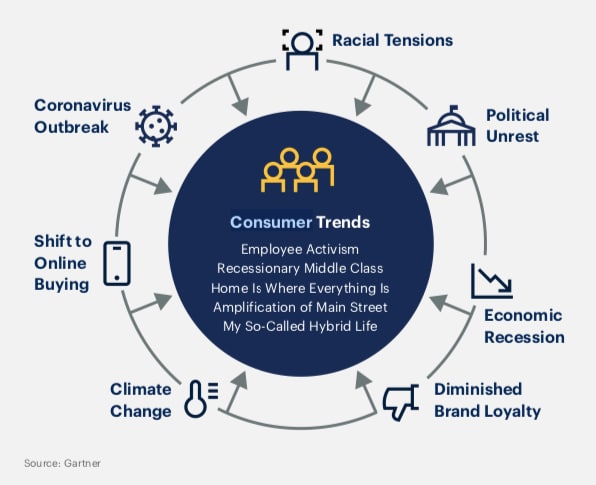
2020 created chaos, pain and uncertainty in our world. 2021 is off to a rough start but filled with progress and hope. As we look toward the big trends for the rest of 2021, one thing is for certain – consumer opinions, preferences and behaviors have changed (by force or choice) and will only evolve more quickly. For brands and their agencies, the imperative for 2021 is to re-connect with consumers at a human level regardless of where they are in their relationship with the brand.
Gartner’s new marketing trends for 2021 states simple that “Postpandemic renewal strategies put marketing on the hook for redefining and reestablishing customer relationships in line with digital’s “new normal.””

Impact of the Pandemic on Consumer Trends in 2021
Throughout the pandemic, workforces have been forced into atomization and isolation, needing to rely on technology to facilitate remote interactions. A year ago, video communication was a tool at our collective disposal, able to put us in touch with friends, loved ones, and colleagues. During 2020, it became our lifeline; the only vehicle we had to connect us. The digital transformation that occurred in the past year was monumental, and a true testament to our ability to adapt but personally and professionally.
This striving for connection and the associated rapid digital response is what we call “agile empathy”; using the tools at our disposal to adapt to new challenges, all in service of learning more about each other, or for brands to learn more about their clientele. Let’s break each of these components down individually to fully understand what we saw this year and what we can expect going forward, potentially for years to come.
A Breakthrough in Agility
Now that we are through Q1 of 2021, we can look back at 2020 and realize that we have just lived through an epochal technological revolution. There are few major shocks to the system that have occurred in the last century: the advent of TV, the rise of the Internet, and the rise of smartphones are three of these big shifts. The emergence of the remote workforce and the necessity for video platforms may become the next phase in this evolution. These tools have the capacity to change population disbursement and alter both the way we view cities but also how we structure our relationship to work.
With an increasingly remote workforce, technological advancement will need to continue apace to meet the moment. Suburban, exurban, and rural populations now seeing an influx of workers exiting cities will need increased access to high speed internet in order to foster emerging talent pools. And this trend isn’t just limited to the US; as the global economy becomes further connected, these strides to bridge the digital divide will become even more prominent, particularly in second and third-world countries.
It may be a coincidence that 5G cellular networks saw massive launches in 2020, or it may be telecommunications companies recognizing this new push towards a more connected world, enabling faster speeds on mobile devices for large portions of the country; and the world.
But the main story of this revolution in technological agility has been the rising prominence and adoption of video platforms integrated into nearly every facet of our work and personal lives.
What felt like a novelty when we started using video communication platforms early in the year quickly—at a pace none of us could have imagined—became the cliched “new normal”. Not only were individuals turning to video platforms to connect with friends and family, it became the engine behind corporate interactions and the preservation of corporate culture, and it was leveraged in major ways by brands and agencies to understand their customers at a time when traditional market research was all but impossible.
An Emphasis on Empathy
Throughout all of the revolutionary digital transformations that occurred in 2020, the through line to all of it was a desire to replicate the in-person interactions of which we found ourselves deprived. Video platforms were quickly adopted because they allowed us the closest thing to personal contact we could get in a pandemic.
Once it became clear that video was the future of interactions, brands, agencies, and insights professionals quickly caught on to the importance of these platforms as a way to understand the changes in consumption and lifestyle and how it affected consumer buying decisions. Smart video platforms in particular—enterprise platforms that draw a distinction from standard video chat through a range of structured, integrated workflow tools for gathering insights—have proven themselves as the way forward for facilitating customer conversations. Brands and agencies are able to extract valuable qualitative data to understand customer motivations and act on them in near real-time. In short, smart video enabled companies to answer the why of customer behavior when it was needed most.
During a year when economic hardships, physical illness, and isolation led to an underlying mental health crisis, the necessity for brands and agencies to discover consumer thoughts, feelings, and motivations—and meet those concerns with empathy and understanding—was essential in 2020 and will continue into 2021 and beyond. During a year where regulations and pandemic response were changing by the day, smart video platforms served as a lifeline for brands gathering insights into consumer emotions and respond in near real-time compared to the pace of traditional focus groups.
Smart video platforms are particularly effective for market researcher professionals because they’re able to meet respondents in their homes, where they’re most comfortable, and gear questions to uncover deeper underlying emotions and motivations. This more mindful approach to moderating has allowed researchers to tap into newfound levels of empathy and speak to customers one-on-one as opposed to larger traditional focus groups to uncover more meaningful insights.
Empathetic Agility is the Future of Market Research
What we’re now learning is that this deeply human, yet profoundly technology-first approach to market research is positioning itself as the way forward. Even with a COVID-19 vaccine rolling out, the way our lives have been upended and refashioned around a more remote society may be an enduring feature.
As a smart video platform, Discuss.io has seen record growth in 2020, seven years into the company’s life. Brands, agencies, and market research firms are now planning two and three years in advance to leverage smart video as a main driver of their qualitative insight gathering efforts, which indicates a commitment to this technology for the future.
Other players in the industry are choosing to get into the teleconferencing and qualitative insight field as well. Cisco’s WebEx division recently acquired audience insight company Slido, and other big-name mergers like Salesforce’s purchase of Slack and SoftBank’s $700 million investment in Sinch have demonstrated an industry-wide interest in omnichannel engagement and insight gathering.
This deployment of smart video is resonating in part because it enables more autonomy and authority among market research team members. Instead of having to go through one main point person, individual moderators are able to take on more organizational responsibility. And with enhanced roles like meeting observer and translator, additional tasks are taken off of a moderator, which enables them to focus on the interview subject and engage in more meaningful ways.
Brands and agencies are not only leveraging smart video to tailor messaging, but to determine broader strategy. Conventionally, the channels of communication would be thought of ahead of time and qualitative insights would be tailored towards those channels. But now, insights gathered through smart video can be used to determine which channel is ideal for messaging; the entire paradigm of omnichannel marketing may be shifting.
2020 was a period of intense emotions, and intense transition. The agility and empathy showcased by individuals and institutions alike was inspiring; but not only that, it may serve as a harbinger of how we interact remotely for years to come.
Key Takeaways:
- 2020 may be seen for years to come as a technological revolution surrounding video communication on par with the rise of the Internet and smartphones.
- The agility showcased by brands, agencies, and consumers in 2020 will continue into 2021 and beyond as remote workforces and emerging global markets require broader access to technology.
- The technological revolution was significant, but it also came in conjunction with an emphasis on empathy; in a year where society was dominated by strong emotions, the ability for brands and agencies to understand their customers’ wants and motivations will be essential in the future.
Sign Up for our Newsletter
Related Articles

From Apathy to Empathy: The 3 Steps to Design for Human Centricity at Scale
By Adam Mertz, Chief Growth Officer at Discuss Introduction I recently had the opportunity to moderate a compelling discussion between…
By Adam Mertz, Chief Growth Officer at Discuss Introduction I recently had the opportunity to moderate a compelling discussion between…

3 Steps to Creating an Intriguing Screener
The reality is that people are busy. They don’t want to take the time to answer screener questions which can…
The reality is that people are busy. They don’t want to take the time to answer screener questions which can…

How to Find the Right Target Audience, Every Time
Recruiting research participants can be one of the most difficult aspects of qualitative projects. But when you do find the…
Recruiting research participants can be one of the most difficult aspects of qualitative projects. But when you do find the…

